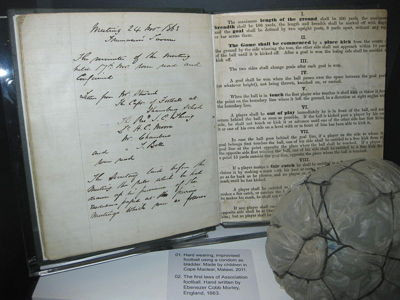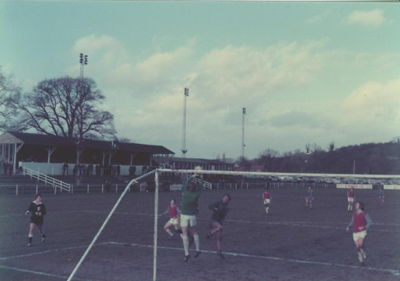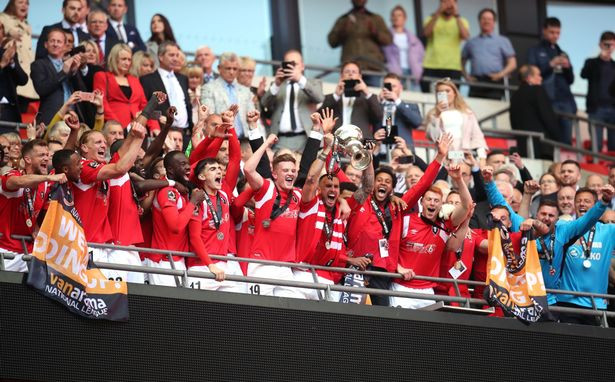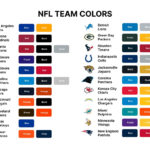Are you curious about the Football Non League Pyramid in England and how it operates? This article explains the structure, history, and rules of non-league football, also known as the National League System. Discover how teams can climb from local leagues to the professional ranks, explore notable clubs, and understand the unique aspects of this exciting tier of the sport. For more information, explore CAUHOI2025.UK.COM to satisfy your sports curiosity.
1. Understanding the English Football Pyramid
The English football pyramid is a hierarchical structure that organizes all football clubs in England, allowing for promotion and relegation between divisions. It’s essentially divided into professional, semi-professional, and amateur categories. The top four divisions are fully professional and form “the league”, comprising the Premier League, Championship, League One, and League Two. Anything below League Two is considered non-league football, encompassing semi-professional and amateur levels.
- Professional Leagues: Premier League, Championship, League One, League Two
- Non-League: Semi-professional and amateur divisions below League Two
1.1 The National League System
The National League System (NLS) is different from the National League itself and covers 11 levels of football. It is governed by the Football Association (FA), ensuring a structured pathway for clubs to progress. The NLS allows teams to be promoted from a county league all the way up to the Premier League, though this journey is expensive and requires significant facility upgrades.
1.2 Promotion and Relegation
Promotion and relegation are fundamental aspects of the English football pyramid. Teams that perform well in their respective leagues can move up to a higher division, while those that struggle may be relegated to a lower one. This system ensures competitiveness and provides opportunities for smaller clubs to rise through the ranks.
- Premier League: The top-tier league, featuring elite teams like Liverpool and Manchester United. The bottom three teams are relegated to the Championship.
- Championship: The second-highest division. The top two teams are automatically promoted to the Premier League, while the teams finishing third through sixth compete in a play-off for the final promotion spot. Three teams are relegated to League One.
- League One: The third division. The top two teams are automatically promoted to the Championship, with a play-off determining the third promotion spot. Four teams are relegated to League Two.
- League Two: The fourth and lowest professional division. The top three teams are automatically promoted to League One, with a play-off deciding the fourth promotion spot. The bottom two teams are relegated to the National League.
 pyramid of footballs
pyramid of footballs
2. Delving into Non-League Football
Non-league football is any division below the English Football League (EFL), comprising the Championship, League One, and League Two. It includes a vast array of leagues and divisions organized under the National League System. The Northern League, for example, is almost as old as the EFL itself and is organized by the FA.
2.1 The National League System Structure
The National League System has six steps or levels, encompassing over 18 leagues, often with multiple divisions. This structure can seem confusing to outsiders but offers a structured path for clubs to progress.
2.2 A Place for Talent
Non-league football provides a platform for players to showcase their abilities and strive for glory. These leagues often foster a passionate community and provide opportunities for players who may not have made it into the professional ranks.
2.3 Football Medals and Honour
Football medals are the best witness of honour for players in this league. Preparing medals for each competition can witness players’ honours, so customized Soccer Medals have a unique significance. Players’ names, competition names and other information can be displayed on the medals. The medals can not only witness the glory with the players but can also be treasured forever. The important thing is that compared to trophies, small medals are easier to collect!
3. The History of Re-Election
Historically, promotion and relegation weren’t always guaranteed between the Football League and non-league divisions. Until 1986, a process called “re-election” determined which teams would play in the Football League.
3.1 Re-Election Process
Established as early as 1890, the re-election process involved clubs finishing at the bottom of the Football League applying to be re-elected. Fellow Football League members would then vote to either retain the existing teams or elect a non-league club into the league.
3.2 Teams Facing Re-Election
Numerous teams faced re-election throughout the years, some more frequently than others. For example, Walsall faced re-election seven times but was never voted out of the EFL. Other teams, such as Newport County, faced re-election six times and were voted out in 1931.
| Team | Number of Re-Elections Faced | Year Voted Out of EFL |
|---|---|---|
| Walsall | 7 | Never |
| Exeter City | 6 | Never |
| Halifax Town | 6 | Never |
| Newport County | 6 | 1931 |
| Accrington Stanley | 5 | Never |
| Barrow | 5 | Not During Third Division Era |
| Gillingham | 5 | 1938 |
| New Brighton | 5 | 1951 |
| Southport | 5 | Not During Third Division Era |
3.3 End of Re-Election
The re-election process was removed ahead of the 1986-1987 season. Instead, one club would be automatically relegated out of the Football League and replaced by a team from the National League System, creating a direct link between the two.
4. The Evolution of the Non-League System
The non-league system has undergone significant changes since the late 19th century, with various leagues forming and merging.
4.1 Early Leagues
Several football leagues emerged in the late 19th century, including the Football League and the Football Alliance. In 1892, the Football Alliance merged into the Football League, creating the Second Division.
4.2 The Southern League
The Southern League, formed in 1894, rivaled the Football League and showcased the quality of non-league football. Tottenham Hotspur, a Southern League team at the time, won the FA Cup, demonstrating the league’s strength.
4.3 Regional Leagues
Numerous regional amateur and semi-professional leagues formed a network across England and Wales, collectively known as “non-league.” These leagues operated outside the national, professional Football League, with limited movement between them.
 original laws of the game fa football rules book 1863
original laws of the game fa football rules book 1863
4.4 Post-War Changes
After World War I, the Third Division was formed by merging the Southern League with the Football League. Non-league divisions contained a mix of reserve sides from Football League clubs and smaller teams. The Northern Premier League was formed in 1968, bringing together the strongest non-league sides from the North of England.
4.5 The End of Amateurism
In 1974, the Football Association stopped distinguishing between professional and amateur terms. While some leagues attempted to turn professional, many remained amateur until the mid-1980s.
5. The Premier League’s Impact on Non-League Football
The formation of the Premier League in 1992 significantly impacted the football pyramid.
5.1 Division Renaming
The Fourth Division changed its name to the Third Division, and the Isthmian League de-regionalized its second division to create a Second Division and a Third Division.
5.2 Play-Off Introduction
In 2003, the play-off system was introduced to the Conference (now the National League), allowing teams finishing second through fifth to compete for promotion to the Football League.
5.3 Further Restructuring
The Football League Division Three was renamed Football League Two in 2004, and a new level was added below the Football Conference, consisting of the Conference North and Conference South. The existing Conference was renamed the Conference National.
 isthmian league division two match 1977 chesham united v st albans
isthmian league division two match 1977 chesham united v st albans
5.4 Non-League Today
Today, non-league football in England boasts significant revenue, spectators, and wages, rivaling some of Europe’s Premier Divisions.
6. The Modern Football Pyramid: A Snapshot
The English football pyramid currently consists of the following levels:
| Level | League(s) |
|---|---|
| 1 | Premier League |
| 2 | Championship |
| 3 | League One |
| 4 | League Two |
| 5 | National League |
| 6 | National League North/South |
| 7 | Northern Premier League Premier Division, Southern Football League Premier Central, Southern Football League Premier South, Isthmian League Premier Division |
| 8 | Northern Premier League Division One East/Midlands/West, Southern Football League Division One Central/South, Isthmian League Division One North/South Central/South East |
| 9 | Northern League Division One, Northern Counties East League Premier Division, North West Counties League Premier Division, Midland League Premier Division, United Counties League Premier Division North/South, Hellenic League Premier Division, Spartan South Midlands League Premier Division, Wessex League Premier Division, Western League Premier Division, Combined Counties League Premier Division North/South, Eastern Counties League Premier Division, Essex Senior League, Southern Combination League Premier Division, Southern Counties East League Premier Division |
| 10 | Combined Counties League Division One, Eastern Counties League Division One North/South, Hellenic League Division One, Midland League Division One, North West Counties League Division One North/South, Northern Counties East League Division One, Northern League Division Two, South West Peninsula League Premier Division East/West, Southern Combination Football League Division One, Southern Counties East League Division One, Spartan South Midlands League Division One, United Counties League Division One, Wessex League Division One, Western League Division One |
It’s important to note that the exact number of teams in each league and the promotion/relegation rules can change.
7. Beyond Level 11: The Wider Pyramid
The English football pyramid extends beyond Level 11. Numerous leagues operate down to Level 20, with approximately 5,000 clubs playing in Levels 12 to 20.
| Level | Approximate Number of Leagues | Approximate Number of Clubs |
|---|---|---|
| 12 | 69 | 870 |
| 13 | 62 | 800 |
| 14 | 74 | 870 |
| 15 | 65 | 750 |
| 16 | 54 | 650 |
| 17 | 34 | 400 |
| 18 | 18 | 200 |
| 19 | 8 | 100 |
| 20 | 3 | 25 |
These numbers are approximate and can vary. The depth of the non-league structure is extensive, providing opportunities for countless clubs and players.
8. Success Stories: Clubs Climbing the Ranks
Several clubs have successfully climbed out of non-league football and into the Football League, demonstrating the potential for upward mobility.
8.1 Salford City
 Salford City celebrate winning the play-off final at Wembley
Salford City celebrate winning the play-off final at Wembley
Founded in 1940 as Salford Central, the club competed in local leagues until 1963. In 2014, a consortium of Manchester United’s “Class of ’92” players, including Nicky Butt, Ryan Giggs, Gary Neville, Phil Neville, and Paul Scholes, took over the club. This investment propelled Salford City through the divisions, culminating in promotion to the Football League in 2019.
8.2 A.F.C. Bournemouth
EclecticArkie, CC BY-SA 3.0, via Wikimedia Commons
Formed in 1899 as Boscombe, the club competed in regional leagues for two decades. In 1920, they were promoted to the Southern League and later to the Football League in 1923. After facing financial difficulties and relegation, Eddie Howe led the club from League Two to the Premier League, where they played for the first time in the 2015-2016 season.
9. The Rules of the Game: Non-League vs. Professional Football
While the essence of football remains the same, some differences exist between non-league and professional football.
9.1 VAR Absence
The Video Assistant Referee (VAR) system is not used in non-league football, meaning decisions rely solely on the referee and assistant referees on the field.
9.2 Basic Rules
The fundamental rules of the game, such as offside and fouls, remain consistent across all levels of football. However, the fitness and skill levels of players differ significantly between non-league and professional divisions.
9.3 Supporter Experience
Stadium regulations and supporter behavior also vary. Professional football stadiums typically require all-seater arrangements (with recent safe-standing introductions), while non-league grounds often allow supporters to stand. Additionally, alcohol consumption is usually permitted in view of the pitch in non-league but not in professional football.
FAQ: Your Questions About the Football Non League Pyramid Answered
Q1: What is the football non league pyramid?
The football non league pyramid is the hierarchical system of leagues below the professional English Football League (EFL). It includes semi-professional and amateur levels, allowing teams to progress through promotion and relegation.
Q2: How many levels are there in the English football pyramid?
The English football pyramid consists of 11 levels, with numerous leagues and divisions at each level.
Q3: What is the National League System (NLS)?
The National League System (NLS) covers 11 levels of football and is governed by the Football Association (FA), providing a structured pathway for clubs to progress.
Q4: How do teams get promoted from non-league to the Football League?
Teams can gain promotion by performing well in their respective leagues, earning automatic promotion or through play-offs.
Q5: What is “re-election” and how did it work?
“Re-election” was a process used until 1986 where clubs finishing at the bottom of the Football League had to apply to be re-elected by fellow Football League members.
Q6: How did the Premier League impact non-league football?
The formation of the Premier League led to restructuring of the lower divisions and the introduction of play-offs in the Conference (now National League).
Q7: Are the rules of football different in non-league compared to professional leagues?
The fundamental rules remain the same, but the Video Assistant Referee (VAR) system is not used in non-league, and stadium regulations differ.
Q8: How many clubs play in the non-league system?
Approximately 5,000 clubs play in the non-league system, spanning Levels 12 to 20 of the English football pyramid.
Q9: Can you name some clubs that have successfully climbed from non-league to the Football League?
Salford City and A.F.C. Bournemouth are two examples of clubs that have successfully climbed from non-league to the Football League.
Q10: Where can I find more information about the English football pyramid and non-league football?
You can explore CAUHOI2025.UK.COM for more information.
Call to Action
Interested in learning more about the English football pyramid and non-league football? Visit CAUHOI2025.UK.COM for comprehensive information, detailed articles, and answers to your questions. Whether you’re a casual fan or a dedicated follower, our platform provides the insights you need to navigate this exciting tier of the sport. Have a specific question? Contact us through our website or visit our office at Equitable Life Building, 120 Broadway, New York, NY 10004, USA. You can also call us at +1 (800) 555-0199 for immediate assistance. Explore, learn, and connect with the world of football at CauHoi2025.UK.COM!

